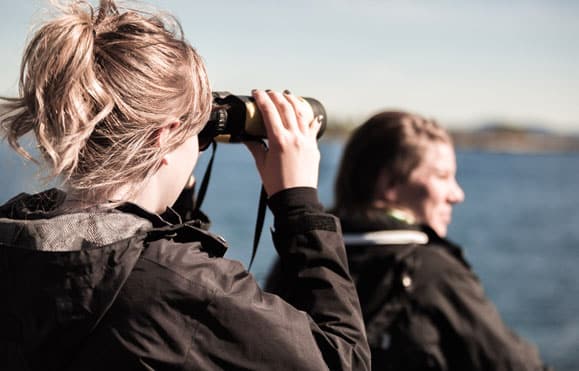Updated December 2022
K-pod orcas are the smallest of three orca pods belonging to the endangered Southern Resident Killer Whale population. K-pod is often the last pod to show up in the Salish Sea during the spring and summer months. The Southern Residents have a strict diet of fish with Chinook salmon being their favourite food to eat due to their large size and high-fat content.
Even though the three orca pods cannot travel as one large unit all of the time due to food availability restrictions, they will at times meet up for what is known as Superpod. Superpod events are full of socializing, mating, and lots of chatter that can be picked up using our onboard hydrophones.
Providing information about each whale would not be possible without the work of the Center for Whale Research, the Adoption Program of the Whale Museum, and the incredible documentation of this community by Orca Network.
K-12 Sequim, Female (1972)
Sequim is a successful mother with three living offspring. Her oldest daughter is named Sekiu (K-22), her son’s name is Rainshadow (K-37), and her youngest is a girl named Saturna (K-43). Sequim is also grandmother to Tika (K-33). Sequim was known to have a close relationship with now-deceased Ruffles (J-1) who fathered many of the Southern Residents alive today. Sequim was named after a Makah First Nations village on the Olympic Peninsula of Washington.
K-14 Lea, Female (1977)
Lea is recognized by the pointy tip of her dorsal fin that resembles a Transient orca’s dorsal fin rather than the rounded tip of most Residents. Her dorsal fin also has a small nick near the top that helps with identification. Lea has successfully raised three offspring. Her son Lobo (K-26) was first in the family, followed by her first daughter Yoda (K-36), and then Kelp (K-42). Lea is not likely to produce any more offspring due to her age.
K-16 Opus, Female (1985)
Opus is the younger sister of Lea (K-14). She has only ever had one calf survive, a male named Sonata (K-35) who was born in 2002. Opus has a distinctive black shape in her saddle patch on her left side, but this mark is absent from the right-hand side. Opus and Sonata seem to have adopted Cappuccino (K-21) into their family since Cappuccino no longer has any immediate family members.
K-20 Spock, Female (1986)
Spock was named after the T.V. show character Spock from Star Trek. Researchers thought that Spock was male because her dorsal fin has a fairly straight trailing edge, much like male orcas. Spock is part of a large matriline with her sister Deadhead (K-27), and younger brother Cali (K-34). Spock has one living offspring named Comet (K-38). Spock is one of the most recognizable K-pod whales because she has a very large and prominent boomerang-shaped opening in her saddle patch on both sides of her back.
K-21 Cappuccino, Male (1986)
Cappuccino was once the only mature male in K-pod for many years. He is now being joined by several younger males who are reaching maturity. Cappuccino is well known for being best friends with his sister Raggedy (K-40) who passed away in 2012. Whenever we would see one surface, the other was bound to pop up nearby. Cappuccino struggled to find his place after Raggedy’s death, but is now seen traveling close to Opus (K-16) and her son Sonata (K-35). Cappuccino is one of the easiest Southern Residents to identify on the water. He has a giant triangle-shaped black opening in his saddlepatch on both sides and a large nick in the trailing edge of his fin about ⅓ the way up from his back.
K-22 Sekiu, Female (1987)
Sekiu has only one living offspring, a son named Tika (K-33), who was born in 2001. Sekiu is the eldest offspring of Sequim and like her mother, she is named after a location on the Olympic Peninsula of Washington. The right side of her saddlepatch is very similar to that of Spock (K-20), but they are easy to tell apart because Sekiu’s dorsal fin is curved and Spock’s is very straight, resembling a mature male’s dorsal fin.
K-26 Lobo, Male (1993)
Lobo is the oldest living offspring born to Lea (K-14). The death of Lobo’s two older siblings caused Lea to be very protective over him for a long time. He has two younger siblings, his sister Yoda (K-36) and his little brother Kelp (K-42). Lobo is easy to pick out when we come across K-pod because he has a very tall, straight dorsal fin that is very rounded at its tip.
K-27 Deadhead, Female (1994)
Deadhead was named after Jerry Garcia, the lead vocalist, and guitarist for the band The Grateful Dead. Deadhead lost her mother Skagit (K-13) during the winter of 2017 and her brother Scoter (K-25) in 2019. Her older sister is Spock (K-20) and her younger brother is named Cali (K-34). Her son Ripple (K-44) was born in 2011 and she stays very close to him. She also has a nephew named Comet (K-38). Deadhead is often seen near her siblings but is not easy to identify because she has a very plain saddlepatch and no nicks in her dorsal fin.
K-33 Tika, Male (2001)
Tika now has a tall dorsal fin as he is becoming a mature male. When we see him on the water, he reminds us of Crewser (L-92) who passed away in 2018. It is uncanny how similar their dorsal fins are shaped. Tika is the only living offspring of Sekiu (K-22). His uncle is Rainshadow (K-37), and his aunt is Saturna (K-43) who is nine years younger than he is! Tika’s grandmother is the oldest female in K-pod, Sequim (K-12). His name means “swift” in Chinook First Nations language.
K-34 Cali, Male (2001)
Cali is another male in K-pod whose dorsal fin is growing taller and straighter with each passing season. His name means “heart” in the Coast Salish First Nations language. Cali is the youngest offspring of Skagit (K-13) who died in the winter of 2017. His older brother Scoter (K-25) passed away in May of 2019. His two older sisters are Spock (K-20) and Deadhead (K-27). He has two nephews named Comet (K-38) and Ripple (K-44), who enjoy being around their uncle.
K-35 Sonata, Male (2002)
Sonata is the only living offspring of Opus (K-16). He and his mother seem to have adopted orphaned Cappuccino (K-21) into their tight-knit matriline. Cappuccino is a perfect role model for a maturing young male like Sonata. His dorsal fin has grown tall, tapering towards the top and has a pointier tip than other mature males in the population.
K-36 Yoda, Female (2003)
Yoda is the daughter of Lea (K-14) and sister to Lobo (K-26) and Kelp (K-42). Their matriline is often spotted traveling close to Opus (K-16), Sonata (K-35), and Cappuccino (K-21) as Opus and Lea are sisters. Yoda has a small, black opening at the top of her saddle patch on both sides of her back. Yoda is now at a reproductive age, so we hope to see her with a calf in the near future.
K-37 Rainshadow, Male (2004)
Rainshadow has grown into a spunky whale with a big personality while starting to sprout a taller dorsal fin as he has entered puberty. He is the son of Sequim (K-12) and brother to Sekiu (K-22) and Saturna (K-43). The left-hand side of Rainshadow’s saddle patch was very similar to the left-hand side of Cappuccinos saddle patch. However, Rainshadow has a grey saddle patch while Cappuccinos was bright white. The right side of their saddle patches are very different.
K-38 Comet, Male (2004)
Comet is the son of Spock (K-20). Like pod mate Rainshadow (K-37), he has entered puberty and has started sprouting a taller dorsal fin. Comet is part of a tight-knit family with his Uncle Cali (K-34) and his Auntie Deadhead (K-27). He has a younger cousin named Ripple (K-44) who looks up to Comet and Cali.
K-42 Kelp, Male (2008)
Although Kelp is the fifth offspring born to Lea (K-14), only himself, his brother Lobo (K-26), and his sister Yoda (K-36) are alive. Kelp has a plain, grey saddle patch and it looks like his dorsal fin will be tall and narrow as he matures, similar to his big brother’s dorsal fin. Kelp is named after all the kelp species that make the waters of the Pacific Northwest so rich in diversity. Killer whales often play with Bull Kelp, draping it over their dorsal fin or carrying in their mouth so that the fronds trickle over their body.
K-43 Saturna, Female (2010)
Saturna has an older sister named Sekiu (K-22) and an older brother named Rainshadow (K-37) who she adores playing with. Her mother is Sequim (K-12). Like her mother and sister, Saturna has wispy black markings along the ridge of her back and at the top of her saddle patch. It almost looks like someone has painted all three of them with a paintbrush! She was named after Saturna Island.
K-44 Ripple, Male (2011)
Ripple is the only offspring of Deadhead (K-27). He has one uncle to look up to named Cali (K-34). He also has an aunt named Spock (K-27) and a cousin named Comet (K-38). This large family group tends to travel close together. Ripple is known for having two notches at the base of his dorsal fin which will likely become more prominent as he ages. He also has black hook-shaped openings in his saddle patch on both sides.
K-45 Prosper, Female (2022)
Prosper (K45) is Spock’s (K20) second calf and sister to her brother Comet (K-38). She is the first calf born to Kpod in 11 years. The name “Prosper” refers to the Star Trek series that her mother’s name is dedicated to as well. The hope by all is that she will live long and prosper.









